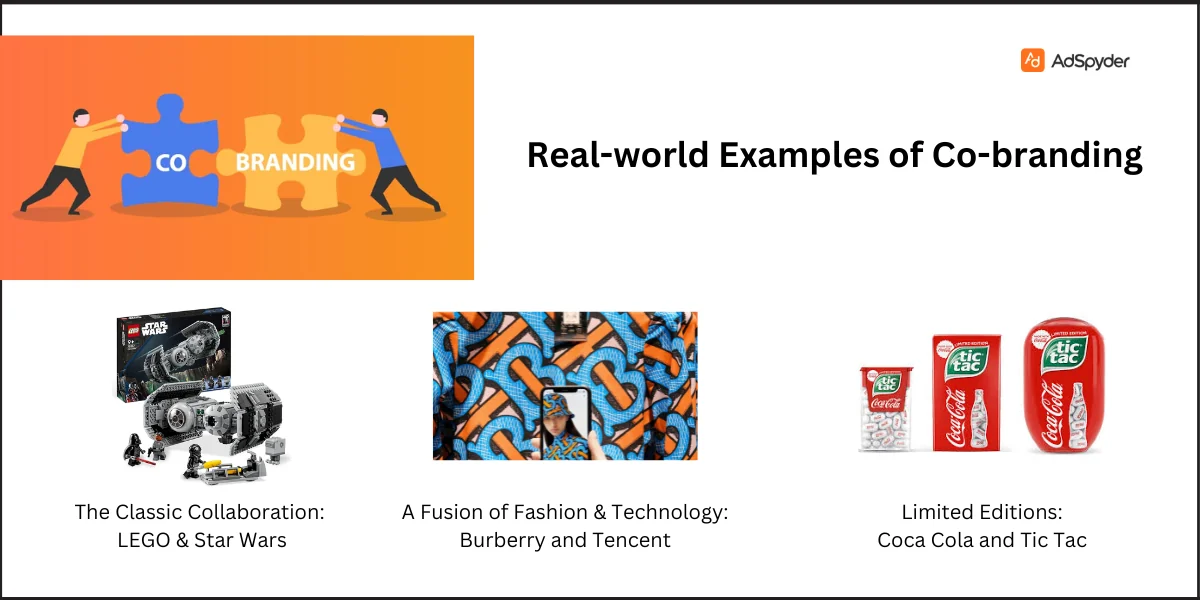Brand communication today is a complex process due to the high level of competition in the market and consequently, brands never cease to find new means of appealing to consumers. One successful approach that brands can employ to enhance brand affinity marketing is co-branding – the process through which two or more brands work together in creating new products, launching new promotions, or offering new experiences If well-executed, co-branding can prove to be a win-win for all the linked brands, increasing the scope of consumers, brand worth, and consumer connections that are built on the values of common ground.
Ready to Elevate your Marketing Strategy?
The Allure of Co-Branding: A Win-Win for Brand Affinity Marketing

The benefits of having a good co-branding partner are many.
- When two partners complement each other well, they can offer value-added services to existing customers and also introduce the brand to new audiences.
- The strategic co-branding benefits result in a genuine sense of association by consumers with all strategic partners.
- Partners complement the customer journey through co-branding and sharing best practices while adapting and building on each company’s story.
Expanded Audience Reach
Co-branding allows brands to tap into the consumer list of the other brand.
- This extends the marketing of products to other segments, which could otherwise be hard to market to.
- The needs of a collaborator should also be mapped to the current customer journey.
- This is to identify areas which a partner could bring value and complement its services.
Enhanced Brand Image
The correct strategic partnership has an elevating impact for both.
- It connects single images and builds a positive image transfer.
- Leveraging on the fact that consumers already have a good impression about the company can also help brands gain high visibility.
- However, it can also be vice versa if the brand chooses to partner with an organization, which may not be so favorable in the public eye.
Increased Brand Awareness
Co-branding initiatives are more brand-marketing communication opportunities.
- This is to engage current brand followers while at the same time trying to attract new customers.
- Integration of the storytelling approach can transform one-off promotional efforts into sustained favorable brand impressions.
Credibility Boost
Partnering with the right company also serves as an endorsement that helps motivate consumers.
- It helps build trust, especially when working with brands that are perceived to be authorities in a certain field.
- But there’s the rub – it’s got to be sincere – collaborations have to look like a logical progression from each company’s character rather than a contrived afterthought.
Innovation and Differentiation
Innovative collaborations here bring about the element of surprise to the existing loyal consumers.
- This provides them with a product or experience they wouldn’t otherwise access. They are also appealing to competitors’ consumers.
- Brands can distinguish themselves by being more selective about the number of partnerships they have with other companies.
- This is in contrast to filling up a line with multiple products of co-branded merchandise.
- You can also go the crowdfunding route. Co-branding a product and creating video marketing strategy for crowdfunding can make the product known. This is especially great if both the brands are at their early stages and are looking to raise funds and create a product.
By leveraging these advantages, co-branding can significantly strengthen brand affinity. When consumers see your brand collaborating with a brand they admire and trust, it creates a positive association that translates into increased brand loyalty and advocacy.
Leveraging Social Media for Brand Affinity
Social media can amplify co-branding efforts by fostering engagement and building a community around the collaboration:
| Platform | Strategy | Example Tactics |
|---|---|---|
| Use visually appealing content to showcase co-branded products and storytelling. | Host joint giveaways, use branded hashtags, and share stories. | |
| Create interactive content like polls or live sessions to engage with both brand audiences. | Host joint Facebook Live events, run targeted ads. | |
| Leverage trending hashtags and real-time engagement for campaign visibility. | Tweet from both brand accounts, use campaign-specific hashtags. | |
| YouTube | Produce co-branded video content such as behind-the-scenes looks, product demos, or interviews. | Launch a co-branded YouTube series, share user-generated content. |
| Share professional insights into the partnership and its impact on industry trends. | Publish case studies, co-author articles on industry relevance. | |
| TikTok | Use short, creative videos to showcase the partnership in a fun, relatable way. | Create co-branded challenges, influencer collaborations. |
| Pin co-branded content that highlights lifestyle integration and product use cases. | Create shared boards, pin how-to guides and visual content. |
Adding these sections will provide more in-depth, actionable content for readers looking to understand and implement effective brand affinity and co-branding strategies.
Beyond the Basics: Strategic Considerations for Effective Co-Branding
A successful co-branding effort requires careful planning and strategic execution. Here are key considerations to maximize the impact on brand affinity marketing:
Identifying the Ideal Partner
- Don’t engage brands haphazardly, or consciously work with competitors.
- Brands should intentionally target those that mirror its brand and audience.
- Sustaining relationships strengthens positioning. Else, relationships can weaken or obscure brand communications.
Crafting a Compelling Narrative
- A consumer of today’s world demands to be as open as possible with a brand that they are providing their loyalty to.
- Marketing via strategic co-branding has an opportunity to solicit consumer involvement through stories across the communication platforms.
- By letting the fans contribute in the process, the brand can get them to emotionally attach to it.
Building Trust and Transparency
- Strategic and ethical business partnerships create credibility and trust in the market.
- Else, people become skeptical about conventional forms of advertising.
- Brand relations can be built on creating joint campaigns that seek to change cultural paradigms.
- These can address similar goals such as environmental concerns, diversity and inclusion initiatives.
Measuring Success Beyond Sales
- One can measure the gross number of sales and market share to determine the impact of a campaign on a company’s or brand’s top line.
- Other metrics such as brand sentiment, increased engagement with the community, and the net promoter scores reflect the emotional connection.
- Finally, after the campaign, quantitative surveys should aim at collecting qualitative data to support the overall strategic direction and creativity implemented.
Must See: Trends in Brand Collaborations 2025
Measuring Brand Affinity Success
To evaluate the effectiveness of co-branding campaigns, use the following metrics:
| Metric | Description | How to Measure |
|---|---|---|
| Net Promoter Score (NPS) | Measures customer loyalty and likelihood of recommending the brand. | Conduct surveys asking customers if they’d recommend. |
| Customer Loyalty Index | Tracks repeat purchase behavior and long-term engagement. | Analyze purchase history and customer lifecycle data. |
| Engagement Rates | Evaluates interactions with branded content, such as likes, shares, and comments. | Use social media analytics tools and website metrics. |
| Brand Sentiment | Assesses public perception and emotional connection to the brand. | Analyze social media mentions and customer reviews. |
| Collaborative Revenue Growth | Measures financial impact directly attributed to the co-branding effort. | Compare pre- and post-campaign revenue data. |
| Customer Retention Rate | Tracks the percentage of customers who continue to engage with the brand after the campaign. | Use CRM data to monitor customer engagement over time. |
| Social Share of Voice (SOV) | Gauges the brand’s visibility and presence compared to competitors during the campaign. | Use tools like Brandwatch to monitor online mentions. |
By following these strategic considerations, you can ensure your co-branding initiatives contribute to building a strong emotional connection with your target audience.
Common Pitfalls in Co-Branding
Identify and avoid these common challenges:
| Pitfall | Impact | Mitigation Strategy |
|---|---|---|
| Mismatched Brand Values | Confusing messaging, diluted identity | Ensure brand values and missions align before partnering. Have proper ad disclosures to prevent legal issues. |
| Unclear Role Definitions | Project delays, conflict | Establish clear roles, responsibilities, and expectations early. |
| Communication Breakdowns | Misaligned strategies, ineffective execution | Maintain regular, transparent communication channels. Follow digital public relations marketing plans. |
| Unbalanced Resource Contribution | Resentment, inequitable brand visibility | Agree on equal contributions and shared resources. |
| Overdependence on Partner Brand | Loss of individual brand identity | Ensure the campaign highlights both brands equally. |
| Inconsistent Customer Experience | Confusing customer journey | Synchronize customer service and brand touchpoints. |
| Failure to Measure and Adapt | Ineffective campaign, wasted resources | Regularly review performance metrics and adjust strategies. |
Examples: The Power of Co-Branding in Action

Let’s explore some real-world examples that showcase the effectiveness of co-branding in building brand affinity marketing
- The Classic Collaboration: LEGO & Star Wars: As LEGO partnered with an entertainment giant like Star Wars since 1999, they not only appealed to the consumers’ fondness towards the storytelling of their beloved franchises but also associated the brand with the following generations through the brand’s favorite building blocks – LEGO bricks.
- A Fusion of Fashion & Technology: One such example is Burberry and Tencent, a Chinese Internet giant and a partner, jointly launched social retail that erased boundaries between physical and virtual worlds and merged tech-savviness with creative direction.
- Socially Conscious Collaboration: TOMS can be termed as cause-related branding since it enables like-minded and responsible consumers. Past brand partners like Disney, MTV, and Wildlife Conservation Society aligned with TOMS’ one-for-one giving model: A purchase of an item leads to giving shoes, eye care, safe water and other products to needy persons.
These examples demonstrate the diverse possibilities of co-branding and its potential to create unique experiences that resonate with target audiences and build strong brand affinity.
FAQs
Yes, especially if you’re looking to expand your reach, boost brand awareness, and strengthen brand affinity. However, ensure your chosen partner aligns with your brand image and target audience.
Look for brands that are similar in many ways in terms of strengths, positioning, and values but also are not currently part of your customers’ experience. Research to establish the lack of coverage and ensure that you have done your homework well on the suitability of a partner.
If the core values of the two companies are not quite in sync with each other and their brands, the communications, management, and positioning of their respective brands may become blurred. However, quality control, expectation setting, and proper communication must be in place to avoid the pitfalls of partnerships.
The duration depends on the type of collaboration. A co-branded product might be a long-term partnership, while a joint marketing campaign could be a one-time initiative.
Brand awareness, consideration, affinity, credibility, and community engagement metrics of consumer perception show positive emotional ROI and stakeholder sell-out records the short-term financial success.
Conclusion
The future of co-branding is brimming with exciting possibilities:
- The Rise of Experiential Co-Branding: While the conventional co-branding is still significant, the new trend that can be observed is the increase of experiential co-branding. The consumers of today are more interested in engagement with brands than simply receiving the messages from them. Thus, the fact that there are familiarization opportunities, such as retail pop-ups and brand ambassador programs, enables the reinforcement of consumer co-creation bonds.
- Data-Driven Partner Selection: The use of customer analytics to target the right strategic partners as well as to assist in the creation of the campaign and the optimization of the same as it runs in order to increase efficiency and effectiveness in the future.
- Focus on Shared Values: Leveraging the relationship between consumers and brands is toxic when there is no genuine passion for the products or when the motive is solely monetary. Companies with aligned core values and purpose create loyalty with target consumers in a relationship.
Embrace these trends and adopt a strategic approach to co-branding. Brands can unlock new avenues for building brand affinity. They can forge meaningful connections with their target audience in the digital marketing landscape. Remember, successful co-branding hinges on collaboration, creativity, and a shared vision for creating value for both brands and their consumers. These can leave a lasting positive impression and cultivate a loyal and engaged brand following.




